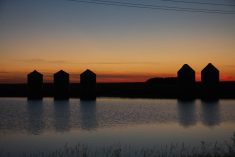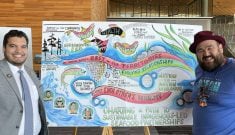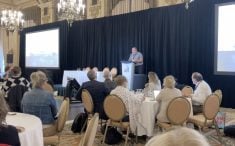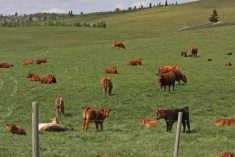It’s not surprising to hear a farmer gripe about government bureaucracy, but it is a little unusual when the source of aggravation is about travelling over the water.
James and Phyl Rolston have had to jump through hoops to satisfy Transport Canada while trying to launch their hovercraft business.
“We thought it was going to be a lot simpler than this,” said James, a grain farmer from Laura, Sask.
They’ve been forced to fly to Southampton, England, to receive training from the manufacturer of the crafts, enrol in marine safety and emergency duties classes, take a marine CPR course and receive full medical exams.
Read Also

Know what costs are involved in keeping crops in the bin
When you’re looking at full bins and rising calf prices, the human reflex is to hold on and hope for more. That’s not a plan. It’s a bet. Storage has a price tag.
“Even to do the demos we need to be certified,” said Phyl.
Meeting all the government regulations has been the most frustrating part of the farm couple’s fledgling business, which began in earnest this spring.
The Rolstons are attempting to sell three models of Hov Pod hovercrafts manufactured by the British company Reaction International Ltd. The crafts sell for $26,000 to $46,000 depending on the model and options.
James bought one for personal use and quickly decided it could become a good source of off-farm income. So far, the River Rider Hovercraft Corp. has been nothing but a drain on finances with the initial cash outlay for three units and costs associated with touring, demonstrations and advertising.
But it’s early days and the couple is confident the business will soon turn into a money-maker. While they have yet to sell one unit there has been plenty of inflatable skirt kicking at the handful of trade shows the couple has attended.
“It’s something (people) all want to get in, they all want to try. But separating them from their cash is the harder part,” said James.
They just came back from SARSCENE, a national search and rescue conference held in Victoria.
James said there was a keen interest in the River Rider crafts due to the challenges presented by some rescue situations.
He heard one story about a hunter who had a heart attack along a river in northern British Columbia. His pal called 911 but the rescue boat got stuck trying to cross the river.
“They could see him but they couldn’t get to him. By the time they got to him he died. If they had one of these (hovercrafts) they could have driven across the river and made the rescue,” said James.
Phyl said the ebb and flow of river systems presents an ongoing challenge for rescuers and adventurers attempting to navigate around sandbars and other obstacles.
“It could be deep enough for a boat one day and too shallow the next day,” she said.
Rescuers face similar issues involving fishermen or snowmobilers who have broken through the ice.
The search and rescue market would be “gravy” for their business that is targeting outfitters that can’t get into shallow lakes and hunters wanting to navigate their way down braided rivers. The business plan calls for eventually selling 10 crafts a year.
James feels it is unlikely River Rider will make many sales into the recreation market, where they would be directly competing with $20,000 jet skis. But he holds out hope that people would be interested in paying for adventure rides up and down the South Saskatchewan River in Saskatoon, which is only a 30-minute drive from the farm.
“We’d take people out for spins over sandbars, doing 360s, wave jumping, gliding around the turns and just getting to places no other craft can get,” he said.
During a recent late-fall thrill ride down the South Saskatchewan River, James chased a flock of seagulls off a sandbar with one of his Hov Pods, which can reach speeds of up to 72 km-h.
The couple sells three models ranging from the 52 horsepower ACX 52 to the 90 hp ACX 90/4. The base model is fitted with a two-stroke Rotax engine, while the top-of-the-line unit has a four-stroke engine.
The amphibious vehicles hold three people and are sold in a variety of colours. No special licence is required to operate the hovercraft but the Rolstons are obligated to provide a thorough training course, which lasts two or three days.
Attending trade shows and demonstrations has been a challenge since most of the leisure shows are held in the summer when James should be tending to their 1,200 acre grain operation and Phyl is busy with her three-quarter time nursing job at a Saskatoon retirement home.
James said he couldn’t have even contemplated the sideline if he and his brother hadn’t split up the farming operation. His brother now owns the cattle while James grows a variety of grains, oilseeds and pulses.
He is thankful to have the help of his 15-year-old son when he’s away attending a trade show. The couple’s two older boys have moved off the farm.
Getting used to juggling his time between two ventures, understanding government regulations and learning the retail side of the hovercraft operation has been a steep learning curve. But when James dons his yellow, helicopter pilot ear protectors and takes one of his Hov Pods out for a rip, he remembers what this venture is all about – a respite from farming.
“I’ve always wanted to be able to get out on the river,” he said.















